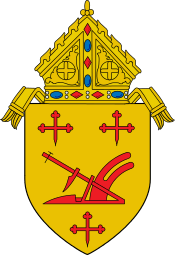Karl Joseph Alter
| The Most Reverend Karl Joseph Alter | |
|---|---|
| Archbishop emeritus of Cincinnati | |
 | |
| See | Cincinnati |
| Installed | June 14, 1950 |
| Term ended | July 19, 1969 |
| Predecessor | John T. McNicholas |
| Successor | Paul Francis Leibold |
| Other posts | Bishop of Toledo (1931-50) |
| Orders | |
| Ordination | June 4, 1910 |
| Consecration | June 17, 1931 |
| Personal details | |
| Born |
August 18, 1885 Toledo, Ohio |
| Died |
August 23, 1977 (aged 92) Cincinnati, Ohio |
| Denomination | Roman Catholic Church |
Karl Joseph Alter (August 18, 1885 – August 23, 1977) was an American clergyman of the Roman Catholic Church. He served as Bishop of Toledo (1931–50) and Archbishop of Cincinnati (1950–69).
Early life
Karl Alter was born in Toledo, Ohio, to John P. and Elizabeth (née Kuttner) Alter.[1] His father was a cigar manufacturer and liquor dealer. He attended St. John's High School, and was a member of the first graduating class of St. John's College in 1905.[2] He made his theological studies at St. Mary's Seminary in Cleveland.[1]
Priesthood
On June 4, 1910, Alter was ordained to the priesthood.[3] He then served as administrator of St. Mary's Church in Leipsic until 1912, when he became a curate at St. John's Church in Lima.[1] In 1914, he was appointed the first diocesan director of Catholic Charities, coordinating various charitable organizations in the diocese into one agency.[1] During this period, he also served as vice-president of the Toledo Social Service Foundation, a trustee of the Toledo Red Cross and of the Toledo Society for the Blind, and a member of the children's division of the state department of public welfare.[2]
He was a lecturer in sociology at St. John's College and at Mary Manse College from 1914 to 1930.[1] He earned a Master's degree from St. John's in 1923 and a doctorate in 1929.[2] In 1929, he was named director of the School of Social Service at the Catholic University of America in Washington, D.C.[1] While in Washington, he also served as chairman of the speakers' committee for the Catholic Hour radio program.[1]
Episcopacy
Toledo
On April 17, 1931, Alter was appointed the third Bishop of Toledo by Pope Pius XI.[3] He received his episcopal consecration on the following June 17 from Archbishop John T. McNicholas, with Bishops Augustus John Schwertner and Joseph H. Albers serving as co-consecrators.[3] He was the first native son of the diocese to become its bishop.[2] He founded the Catholic Chronicle in 1934. In 1938, he deplored religious persecution in Germany and unrest in the Holy Land.[2] Along with fellow American bishops, Alter publicly criticized the Moscow Agreement of 1943.[4] In 1944, he drafted a proposal for a joint declaration on world peace by Catholic, Jewish, and Protestant leaders.[2]
Following World War II, he offered a 10-point program for economic security; among his points were such contemporary ideas as wage equalization on the basis of cost of living, representation of laborers on a firm's board of trustees, profit-sharing, and special consideration for persons living on fixed incomes.[2] During his tenure as bishop, the construction of Rosary Cathedral was completed and an addition to Central Catholic High School was built.[2] He established DeSales College in 1942 and donated a 12-acre (49,000 m2) parcel of land in East Toledo for the construction of St. Charles Hospital.
Cincinnati
Following the death of Archbishop McNicholas, Alter was appointed the fifth Archbishop of Cincinnati on June 14, 1950.[3] During his administration, he established 98 churches, 94 elementary schools, 14 high schools, 79 rectories, and 55 convents.[2] He also instituted a priests' senate and an archdiocesan school board composed of lay members, and encouraged the formation of parish councils. He undertook a restoration of Saint Peter in Chains Cathedral.[2]
Within the National Catholic Welfare Conference, he served two terms as vice- chairman (1950–52, 1956–58), two terms as chairman (1952–55, 1958–62), and one term as secretary (1962–66).[1] As chairman of the NCWC, he issued a protest against religious and racial discrimination in June 1960. Between 1962 and 1965, Alter attended all four sessions of the Second Vatican Council, having previously served on the Central Preparatory Commission. At the Council, he sat on the Commissions for Bishops and for the Government of Dioceses. He discontinued first grades in Cincinnati parochial schools in 1964 because of high costs and overcrowded classrooms.[5] However, Alter did not believe that this would greatly interfere with children's religious education[5]
He resigned as Cincinnati's archbishop on July 19, 1969, after nineteen years of service. At the same time Alter was appointed Titular Archbishop of Minora, a post from which he stepped down on December 31, 1970.
Alter died in Cincinnati at age 92. Archbishop Alter High School in Dayton is named in his honor, as was the former Alter Elementary (now All Saints Catholic School) in Rossford, Ohio.
References
- 1 2 3 4 5 6 7 8 Curtis, Georgina Pell (1961). The American Catholic Who's Who. XIV. Grosse Pointe, Michigan: Walter Romig.
- 1 2 3 4 5 6 7 8 9 10 "Archbishop Karl Alter". Toledo Blade. 1977-08-23.
- 1 2 3 4 "Archbishop Karl Joseph Alter". Catholic-Hierarchy.org.
- ↑ TIME Magazine. Moscow: Catholic View November 22, 1943
- 1 2 TIME Magazine. Schools Under Strain March 20, 1964
| Catholic Church titles | ||
|---|---|---|
| Preceded by Samuel Alphonsius Stritch |
Bishop of Toledo 1931–1950 |
Succeeded by George John Rehring |
| Preceded by John Timothy McNicholas |
Archbishop of Cincinnati 1950–1969 |
Succeeded by Paul Francis Leibold |

